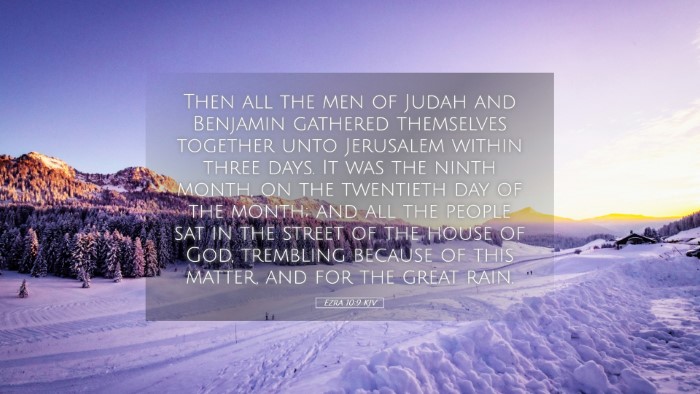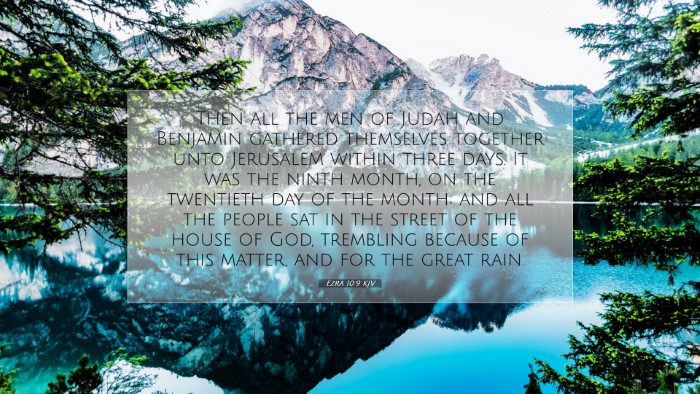Commentary on Ezra 10:9
Ezra 10:9 states, "Then all the men of Judah and Benjamin gathered themselves together unto Jerusalem within three days. And it was the ninth month, and the twentieth day of the month; and all the people sat in the street of the house of God, trembling because of this matter, and for the great rain."
Contextual Background
The book of Ezra is a historical account that details the return of the Jewish exiles from Babylon to their homeland and their efforts in rebuilding the Temple and restoring the community centered on God’s law. Ezra 10 specifically addresses the problem of intermarriage with foreign women, a concern that arose as the Jews returned to Judah. This situation necessitated a decisive response, leading to the convening of the community as described in this verse.
Gathering of the People
In this verse, we witness the urgent response of the people to Ezra’s call for reform. The mention of the "men of Judah and Benjamin" signifies unity among the tribes of Israel in facing the crisis of their covenant fidelity.
-
Immediate Response: Matthew Henry emphasizes the importance of this rapid gathering. The people assembled within three days, reflecting their seriousness about the issue and their willingness to confront sin openly and collectively.
-
Unity in Crisis: Albert Barnes notes that this unity displayed the communal aspect of faith. The gathering of both tribes indicates that the issue transcended individual concerns; it was an affront to their collective identity as God’s chosen people.
-
Significance of the Time: Adam Clarke provides insight into the timing. Occurring in the ninth month during the rainy season, it symbolizes a time of tumultuous weather, paralleling the inner turmoil experienced by the people as they grappled with the gravity of their situation.
Trembling Before God
The phrase "trembling because of this matter, and for the great rain" carries significant theological weight. The trembling implies a deep recognition of guilt and the awareness of God’s displeasure, as they understood the gravity of their disobedience.
-
Fear of Divine Judgment: Matthew Henry notes this trembling as reflective of a heart contrite before God, sensing the seriousness of their plight. The fear of repercussions serves as an avenue toward repentance.
-
Symbolic of Spiritual Condition: Albert Barnes draws attention to the external conditions—the great rain—as synonymous with the internal turmoil. It also implies God’s involvement in the affairs of men, suggesting that physical storms can mirror spiritual storms.
-
Acceptance of Accountability: Adam Clarke argues that trembling can also signify an awakening to personal accountability among the people, which is crucial in the process of communal repentance and restoration.
Theological Implications
Ezra 10:9 offers profound insights into both the nature of sin and the path to redemption. It warns against the destructive consequences of unfaithfulness while also underscoring God's readiness to restore those who turn back to Him.
-
Sacred Responsibility: The gathering illustrates that being part of the community of faith involves mutual responsibility toward one another in upholding covenant practices.
-
Grace in Judgement: Even in their trembling, there is an indication of hope. As they come together in fear, it can lead to repentance and ultimately, a deeper reliance on God’s redemptive grace.
-
Spiritual Awakening: The collective acknowledgment of their situation suggests a spiritual awakening. This theme is resonant throughout scripture, indicating that moments of crisis can lead to transformational encounters with God.
Practical Applications
For pastors, theologians, and students of the Bible, Ezra 10:9 encapsulates core principles of spiritual leadership and communal faith.
-
Leadership and Accountability: Spiritual leaders must call their communities to holiness, recognizing the importance of confronting sin collectively rather than in isolation.
-
Responding to God's Call: The urgency displayed by the people in coming together should be a model for contemporary believers in responding promptly to God’s conviction.
-
Fostering Unity in Diversity: The unity of Judah and Benjamin serves as an example of how to embrace fellowship and collaborative repentance in diverse congregations.
Conclusion
In summary, Ezra 10:9 encapsulates a pivotal moment in Israel's history that speaks to the timeless themes of accountability, unity, and redemption. As believers reflect upon this scripture, they are encouraged to acknowledge the seriousness of sin and the necessity of coming together before God in humility and repentance. The physical gathering amidst spiritual trembling beckons a deeper and more profound approach to worship, accountability, and communal faith practices in today's context.


